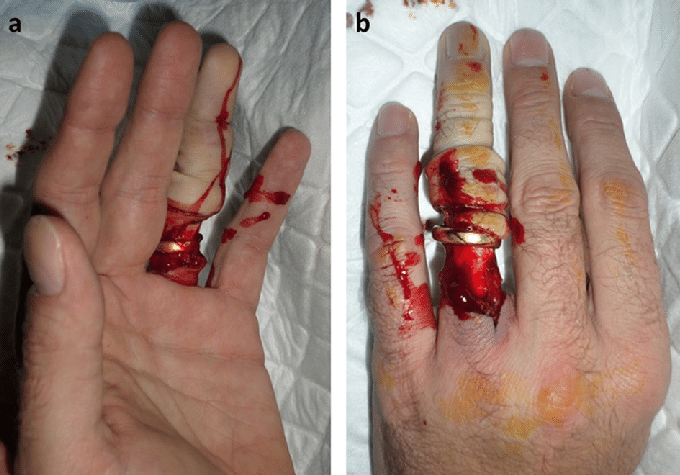What are the symptoms of ring avulsion?
Ring avulsion, which occurs when a ring or other object gets caught and pulls on the finger, leading to severe injury, typically presents with the following symptoms:
- Severe Pain: Intense pain at the site of the injury.
- Swelling: Significant swelling of the finger.
- Bruising: Discoloration or bruising around the finger.
- Lacerations: Cuts or tears in the skin, possibly extending to the deeper tissues.
- Numbness: Loss of feeling or numbness in the affected finger, if nerves are damaged.
- Disfigurement: The finger may appear misshapen or deformed.
- Loss of Function: Difficulty moving or using the finger due to pain or injury.
Immediate medical attention is crucial to manage the injury, prevent complications, and restore function.
What are the causes of ring avulsion?
Ring avulsion is typically caused by situations where a ring or other object gets caught and pulls forcefully on the finger. Common causes include:
- Accidents: Everyday activities where a ring gets caught on an object, such as clothing, machinery, or furniture.
- Sports Injuries: Rings getting caught during physical activities like sports or exercise.
- Workplace Incidents: Industrial or manual labor environments where rings can become entangled in machinery or equipment.
- Trauma: Accidental injuries where the ring is pulled forcefully, such as in falls or accidents.
In general, any situation that involves a sudden, strong pulling force on a ring or object can lead to ring avulsion.
What is the treatment for ring avulsion?
For treating ring avulsion, the focus is on immediate care and often involves surgical intervention. Initially, if the ring is still on the finger, it should be carefully removed, especially if it is causing more damage. To control bleeding, gentle pressure should be applied, and the hand should be elevated if possible. The wound should be cleaned gently with water to remove any debris, but harsh chemicals or scrubbing should be avoided.
It’s essential to seek professional medical care for evaluation, particularly if the injury is severe or the ring cannot be removed easily. In some cases, surgeons may attempt to reattach the avulsed tissue, although this depends on the extent of the injury. Alternatively, surgery may involve debridement, where non-viable tissue is removed.
Wound care is crucial, which involves proper dressing and bandaging to protect the wound and promote healing. Pain management with medications may be necessary to handle discomfort, and regular follow-up visits might be needed to monitor the healing process and address any complications. In cases where function and mobility are affected, physical therapy may be recommended to aid in rehabilitation. Immediate medical attention is important to ensure proper treatment and minimize the risk of complications.

Leave a Reply
You must be logged in to post a comment.